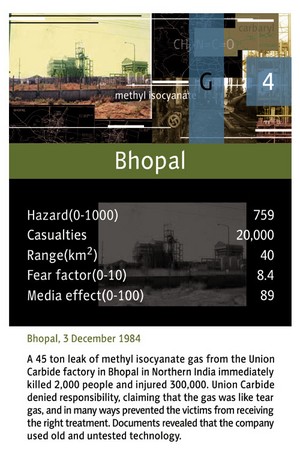|

In the middle of the night, people living around the Union Carbide chemical factory in Bhopal woke up coughing, their eyes burning, thousands of them already dying from the 45 tons of methyl isocyanate gas (MIC), which was leaking from the factory.
Panic broke out and the police instructed people to run away from the gas, but by doing so they inhaled even more gas. They did not know that lying still with a wet cloth over their mouth might have saved their lives. The next morning 2,000 people were dead and 300,000 were injured.
In the following days, 1,500 more people died and nearly 600,000 fled the city. Over the following 15 years, 15,000 more people died of the after-effects from the accident.
Many of these victims could have survived had it not been for Union Carbide�s response to the accident. Shortly after the gas leak, local hospitals called the factory to ask which gas had affected the victims and what treatment to give them. The Bhopal official answered: �It�s MIC and it is like tear gas. Irritant, but non-poisonous. And the treatment is to wash with water.�
In the following days, several Union Carbide officials kept valuable information from the doctors and repeated the tear gas analogy. �Medical experts� invited to Bhopal, officially to help the victims, by Union Carbide, stated again and again that the leaked gases would not have a long-term health effect on the exposed persons.
Indian officials strongly recommended detoxification of survivors by means of sodium thiosulphate, but The Union Carbide quickly realised that this treatment would reveal the fact that the leaked gas had entered the blood stream and caused much more damage than any tear gas.
Union Carbide therefore used their influence in the Indian government to effectively prevent this treatment from reaching the victims.
In the following years, the company did everything possible to deny their responsibility. In the Indian Supreme Court they were convicted to pay for a hospital, which they reluctantly did, but a few years later, by abusing the Indian laws, they succeeded in making the Red Cross pay back the money and the hospital had to close. In a later trial, they were again convicted to pay and they did: 4 dollars to each survivor.
Union Carbide has now changed its name to Dow, but the story is not over yet. Internal documents from the company show that Union Carbide decided to abandon the factory without cleaning up the chemicals from the ground and water though they knew that they were thereby contaminating the next generation as well.
The documents also revealed that the company used old and untested technology in order to increase profit and that this was probably the cause of the leak. Union Carbide itself claimed that the leak happened because of sabotage from an Indian worker.
Comment this page
 
Links and references:
CorpWatch: Holding Corporations Accountable:
http://www.corpwatch.org/
A chapter on Bhopal can be found in:
http://Derrick Jensen: The Culture of Make Believe...
Bidwai, Praful. Making India Work - for the Rich:
http://www.tni.org/archives/bidwai/making.htm
Union Carbide Corporation: Information Archive-Articles and Case Studies. Bhopal:
http://www.bhopal.com/infoarch.htm
Zacharia, Joseph. Kerosene Recovery in Textile Printing:
http://www.emcentre.com/unepweb/tec_case/textile_1...
TED Case Studies: Bhopal Disaster:
http://www.american.edu/TED/BHOPAL.HTM
Jamwal, Nidhi. India: Construction Industry Uses Toxic Waste:
http://www.corpwatch.org/news/PND.jsp?articleid=55...
Investigation of Large-Magnitude Incidents: Bhopal as a Case Study
http://www.bhopal.com/pdfs/casestdy.pdf
Pesticides News No. 46, December 1999, pages 4-5:
http://www.pan-uk.org/pestnews/pn46/pn46p4.htm
http://home.earthlink.net/~gnproject/chemcentury.h...
Mitchell, James K. Long-term recovery from the Bhopal crisis.
http://www.unu.edu/unupress/unupbooks/uu21le/uu21l...
For the calculation of the number of victims, we have used the following sources:
http://www.bhopalexpress.com/story.html
See photos:
http://www.m-web.com/bhopal_photos.html
Read the explanation of the CEO of DOW:
http://bhopal.doesntexist.com/
This is Dow�s official Bhopal site with their own version the tragedy:
http://www.bhopal.com/
This is the main NGO-site for the Bhopal tragedy:
http://www.bhopal.org
A report to commemorate the 15th Anniversary of the Bhopal Disaster:
http://Beyond the Chemical Century: Restoring Huma...
|



